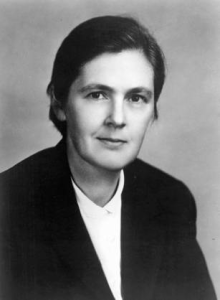 Dr. Frances Kelsey, a physician and pharmacologist at the U.S. Food and Drug Administration who was credited with largely averting the tragedy wrought by thalidomide in other parts of the world, passed away on Friday at the age of 101. As the Washington Post reported, she held up its approval and helped gather evidence of the drug’s link to the deaths of babies as well as tens of thousands of severe birth defects.
Dr. Frances Kelsey, a physician and pharmacologist at the U.S. Food and Drug Administration who was credited with largely averting the tragedy wrought by thalidomide in other parts of the world, passed away on Friday at the age of 101. As the Washington Post reported, she held up its approval and helped gather evidence of the drug’s link to the deaths of babies as well as tens of thousands of severe birth defects.
Clearly there was a market failure of epic proportions and the U.S. is tremendously lucky Kelsey and the FDA prevented the drug from being sold here. Is this a case of scientific best practices being under-developed in the ’60s and could such a failure repeat itself today without the intervention of a regulator? It’s hard to imagine a company doing today what these companies did in the 1960s, not out of fear of the FDA, but how the market would punish it if it had failed to conduct rigorous clinical trials, scientific testing and so on.
The Precautionary Principle
That’s not to suggest that a regulator has no role in approving drugs in the U.S. However, Professor Richard Epstein and others have long argued that the opposite problem exists in the US today – drugs that could save and improve lives in the US take too long to reach our patients, especially in the case of patients who have exhausted all available alternatives and should be able to decide with their doctors whether to try potential breakthrough treatments that haven’t yet been approved. In other words, the regulatory approach has gone from too light, to too strict.
In many ways, what’s being applied to drugs here is the precautionary principle. That is, if there’s even the remotest possibility that a drug might cause harm, we should hold off approving it. One of the more basic examples of the outcome of this approach is the FDA’s approval (or lack thereof) of sunscreens. As the Wall Street Journal (WSJ) has written:
Since the 1990s, advanced sunscreens that counter the UV-A rays that contribute to carcinomas have been widely sold in Europe, Canada and Asia. Americans must rely on an older generation that merely prevents sunburn, because since 2002 the FDA has refused to provide up-or-down answers for eight pending applications to approve the superior compounds.
In spite of literally decades of use in other countries, we in the U.S. must get by with inferior sunscreens, which as the WSJ noted will likely result in cases of skin cancer that would be preventable, if we could use what our friends overseas apply when they’re at the beach. Remarkably, the FDA now says that it applied a different regulatory standard to the current sunscreens on the market here when they were approved; in other words, it probably would have rejected what we’re using today.
Global Warming
The precautionary principle is what advocates of “doing something” about climate change often rely on when they call for drastic cuts in carbon emissions, carbon taxes or trading schemes. I’ve explained my position on global warming in detail before, including the remarkably poor track record of apocalyptic predictions by some scientists, policy makers and the Al Gores of this world. Nigel Lawson recently summed up the precautionary principle in relation to this topic:
If there is a connecting thread among all these irrational prophecies, and the profoundly harmful policies that the doomsters recommend, it is the precautionary principle…Based on a confusion between the sensible precept “be careful” and the nonsensical proposition that you can’t be too careful, it insists on taking the worst-case scenario as the outcome that should dictate policy. On that basis, one would never get in a car.
From an individual standpoint, not using an automobile for fear of the many negative outcomes that might befall you would mean lost job opportunities, income and more. The same sorts of outcomes would result at a global level if we implement the massive carbon emission reductions some policy makers advocate for.
I’ve explained before that while it’s true there’s a consensus the world has warmed over the past 100 years or more, there’s no scientific consensus that man is responsible. Many distinguished scientists believe we’ve got little or nothing to do with the warming trend at a global level. And as I’ve noted at a local level, scientists attribute natural variation and no impact from man for all of the warming on the West Coast of the United States.
Interestingly, the Washington Post article on Dr. Kelsey explains that at the time she had a hold on thalidomide’s approval in the U.S., the “scientific consensus” was that babies in the womb were protected from absorbing toxins and other things consumed by the mother by a “placental barrier”.
“…a prevailing view among doctors held that the placental barrier protected the fetus from what Dr. Kelsey once called “the indiscretions of the mother,” such as abuse of alcohol, tobacco or illegal drugs.”
In other words, Kelsey was skeptical of the prevailing view among her fellow doctors and thank goodness for this country she was. RIP Dr. Kelsey and thanks for both your skepticism and your service to the United States. Although I was born some time after this tragic event, I still remember seeing what happened to New Zealanders and Australians who were unfortunate enough to be affected by this drug and learning from my mother why and what caused it.
Leave a Reply
You must be logged in to post a comment.